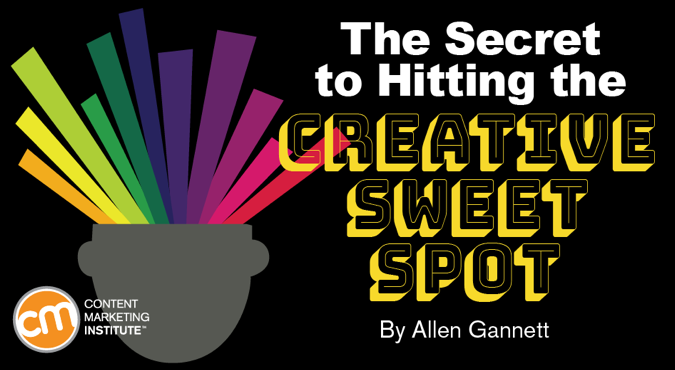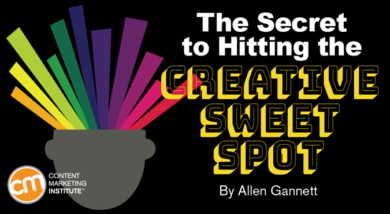 This article is adapted from an excerpt in the new book The Creative Curve by Allen Gannett, from Penguin Random House.
This article is adapted from an excerpt in the new book The Creative Curve by Allen Gannett, from Penguin Random House.
Most of what you know about creativity is a lie.
Our culture has embraced the idea that creative genius is inborn and innate.
And, if you’re not one of the privileged few with creative skill in your genes, there’s not much you can do to change that. You’re either a brilliantly creative content marketer or you’re not. That’s how the creativity story goes.
And it’s totally, completely, utterly wrong. You can teach yourself to become more creative.
I’ve spent the last three years speaking with creative experts of all stripes. I sat down with Michelin star restaurateur José Andrés; Netflix CCO Ted Sarandos; reddit co-founder Alexis Ohanian; The New York Times writer and co-creator of Billions, Andrew Ross Sorkin; YouTube superstar Casey Neistat; creator of Black-ish, Kenya Barris; Jerry Greenfield of Ben & Jerry’s; and countless other creative heavyweights.
To understand the scientific processes behind creative insight, I chatted with leading neuroscientists and pioneering academics.
Here’s what I learned.
To improve your creativity, you need to understand the two titanic forces behind every instance of creative success: familiarity and novelty.
To improve creativity, know the two titanic forces behind success – familiarity & novelty, says @Allen. Click To TweetAttracted to the familiar
In 1968, Robert Zajonc conducted a study that would revolutionize the field of psychology. He recruited students at the University of Michigan for a “language learning experiment.”
He showed them “Chinese characters,” claiming they signified various adjectives. Students saw the characters at varying frequencies before rating their positivity (i.e., a good trait or bad trait) and how much they “liked” the character.
The “Chinese characters” had no meaning. The study tested whether frequency affected their feelings. And it did. The more often participants saw a character, the more positively they perceived it. They liked the character just because they saw it more.
Put another way, familiarity is attractive. We feel safe.
But, there’s a problem with this conclusion.
Have you ever noticed that when a new iPhone model comes out, the old one seems less attractive? If people are more comfortable with things that are familiar, shouldn’t everyone be carrying iPhones from 2008?
The attractive power of familiarity is limited by something. And the same researcher discovered what that is.
Interested in novelty
Imagine you’re walking through an art museum and you see this abstract painting.
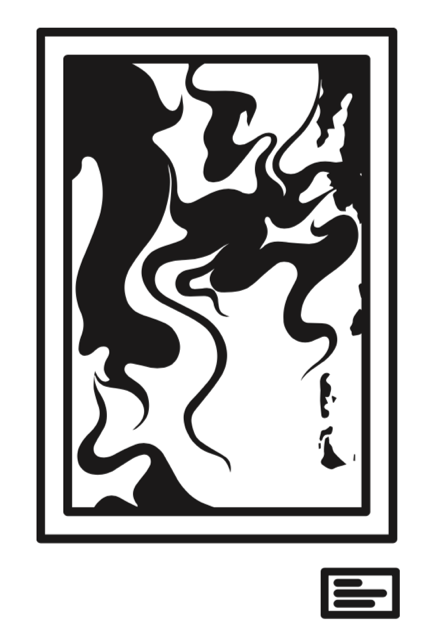
Now imagine you walk by it five more times. Would seeing it repeatedly change your opinion of the work? What if you saw it 10 times? 25 times?
Robert Zajonc’s team of researchers conducted a similar experiment. Paintings seen by students 25 times were about 15 percent less liked than ones seen for a single time. In short, the students preferred novel paintings more than familiar ones.
Now we know we are motivated by novelty and fear of the unfamiliar. How do we balance our interest with our apprehension?
Intersection of familiarity and novelty
Researchers at the University of Toronto and the University of Montreal wanted to know.
They played clips from a half-dozen songs for 108 students. Students reported liking a clip more the second through eighth time they were exposed to it. But they liked it progressively less between the ninth and 32nd plays.
Both of Zajonc’s studies are correct, but neither provides the full picture. At first, the more we are exposed to something the more we like it. Once that exposure reaches a peak, we tire and like that thing less and less each time we encounter it.
If you graph the interplay between familiarity and novelty – between nostalgia and excitement for the new – you get a distinct shape.
Embrace the creative curve
The pursuit of both familiarity and novelty results in a bell-shaped curve relationship between preference and familiarity. I call this bell-shaped curve the creative curve.
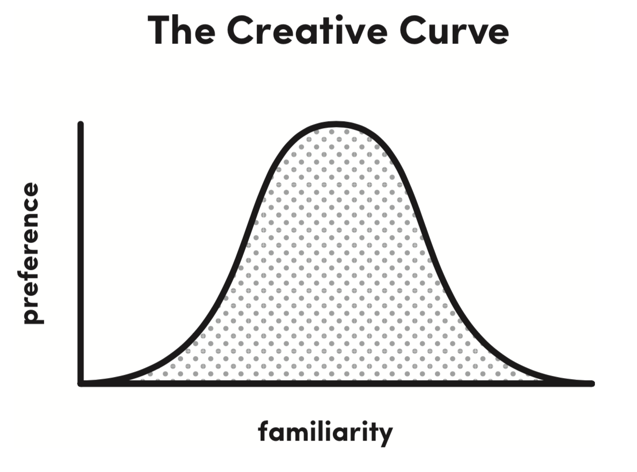
Here’s how it works.
Creative insights aimed at the bottom right part of the curve won’t be long for the world. Too much novelty and not enough familiarity means that the idea will attract fringe interest but most people will stay away.
As the curve slopes up, familiarity increases and novelty sinks to non-threatening levels. The upward slope is what I call “the sweet spot” of the creative curve. Ideas in this region are familiar enough to be comfortable, yet novel enough to compel attention.
But as people become more and more familiar with the new idea, the novelty bonus deteriorates. Then, we reach the point of cliché, where familiarity and novelty are perfectly balanced.
Novelty bonus deteriorates as people become more familiar with a new idea, says @Allen. Read more>> Click To TweetIt’s a bad idea to aim an idea at any part of the curve past the point of cliché. Many ideas become a follow-on failure. For example, if you opened a cupcake shop in 2015 soon after the cupcake craze had peaked, you might have had a busy year. By 2016 or 2017, you likely would have experienced a sudden drop in business.
Put that all together and here’s what you get.
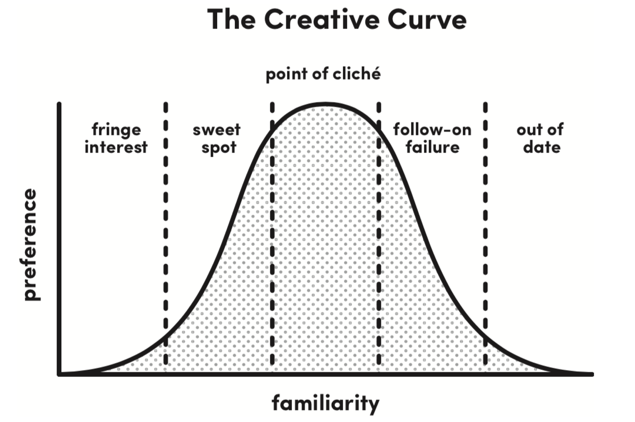
Case study: Clothing brand Ed Hardy
Let’s look at how the creative curve operates in real life.
Don Ed Hardy was a tattoo artist originally best known for his Japanese-inspired designs at Tattoo City, the San Francisco studio he opened in 1977.
In the late 2000s, businessman Christian Audigier convinced Hardy to license his designs. Audigier’s branding acumen made Hardy’s artwork a smashing success. By mid-2009, the snakes and skulls of Hardy’s tattoos were plastered on anything and everything.
Suddenly, Ed Hardy was a household name. And this ubiquity was big money. In 2009, the Ed Hardy brand sold $700 million in clothing and accessories.
Familiarity had created an empire.
But familiarity giveth, and familiarity taketh away.
After 2009, Ed Hardy shirts were a gaudy cliché. By 2016, the brand was gasping for air.
How did a brand climb so high then tumble so far?
Let’s look at Google. The search engine giant’s tool shows the number of people who search for a phrase over time. It’s a good way to observe and time trends. What happens when we plug in the words “Ed Hardy”?
.@Google search trends can illustrate a topic’s creative curve, says @Allen. Click To Tweet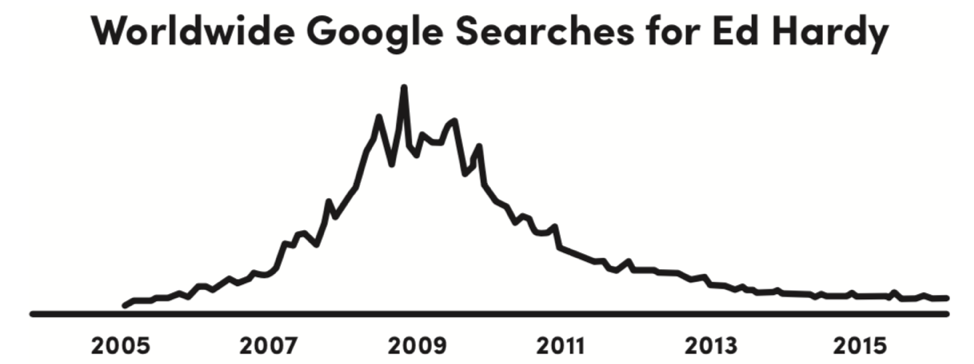
Notice anything familiar?
Putting the creative curve to work
Content marketing is all about providing value to your audience. And that’s why creativity is so important.
Your audience has seen the same five tricks repeated 500 times. Repetition is boring, and boring doesn’t add value. That’s where creativity comes in. If you can provide something novel and exciting, you’ll catch eyes and hold focus.
But here’s where people mess up. You need to balance this novelty with familiarity.
Creative success requires a balance of novelty and familiarity, says @Allen. Read more>> Click To TweetIf you offer a bold take on a topic and a revolutionary method of presentation and do it at an unexpected time, you risk novelty overload. Pick one creative angle and commit to it fully. Don’t change too many things at once. Repaint the wheel, don’t reinvent it. Too new is sometimes as bad as too boring.
Content marketers who learn how to strike the perfect balance between the familiar and the novel will set themselves up for dependable and repeatable creative success.
Adapted from THE CREATIVE CURVE: HOW TO DEVELOP THE RIGHT IDEA, AT THE RIGHT TIME © 2018 by Allen Gannett. Published by Currency, an imprint of the Crown Publishing Group, a division of Penguin Random House LLC.
Catch Allen and his insight on LinkedIn video at one of hundreds of sessions at Content Marketing World Sept. 4-7 in Cleveland, Ohio. Register today using code BLOG100 to save $100.
Cover image by Joseph Kalinowski/Content Marketing Institute

